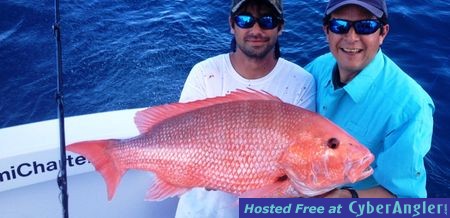Bottom and Wreck Fishing in Miami
Capt. Carlos Mendez
November 25, 2014
Miami - Saltwater Fishing Report

Fishing in Miami offers a multitude of choices to the angler. While the exotic sailfish and colorful, tasty dolphin may be primary, many anglers opt for bending the rod over our bountiful wrecks. The majority of our ship wrecks were intentionally sunk in depths suitable to divers and fisherman. The shallow wrecks produce smaller fish, but the deeper wrecks located in 200 or more feet of water are the most productive. Fishing the deep wrecks is an art, dependent upon locations and knowledge of prevailing conditions. The Gulf Stream current normally flows to the North at varying speeds. Unfortunately, those conditions are not predictable.

Arriving on the site, the captain must find out the current's direction and velocity as well as the wind direction with GPS and land ranges. This is called finding your set and drift and if you nail it you will find the proper starting point for your drift.
Once over the wreck the fish finder will normally come alive. Generally, Captain Mendez approaches a wreck from down current, north toward south against the northward current flow. He will pass over the wreck, viewing it on fish finding and depth recording equipment. The Masita III will continue past the observed wreck toward the south. Judging the speed of the current, Captain Mendez will signal the mate to have the anglers drop their weighted lines and live baits.
Captain Mendez assesses current speed and bumps the boat in and out of forward gear as necessary to maintain the fishing lines in a vertical to slightly aft slant from the transom. As the current pushes the boat from bow to stern toward the north, the current will carry the Masita III, over the wreck and its inhabitants. When a strike is detected, the angler immediately reels in line to remove slack that has been bellied to the south by the Gulf Stream current. At the same time, Captain Mendez accelerates the boat ahead to assist in slack removal and hookup. Once the fish is hooked, the boat continues in a south bound direction, employing the northward flow of the stream to apply resistance against the fishing line, elevating the hooked fish and denying its attempt to reach the sanctuary of the wreck's obstructions. Once the threat has been eliminated, the angler endures a grueling battle with anticipated surges toward the bottom. The angler has the predetermined selection of standup gear with appropriate gimbal belts and harnesses or the fighting chair.
Wreck fishing provides the possibility of an assortment of species, including grouper, snapper, African pompano, cobia, barracuda, amber jack and more. The Masita III also deploys live baits from rigger and flat lines while dropping on the wrecks, frequently enticing sailfish, dolphin, wahoo, tuna and bonitas. Should there not be a hookup as Masita III courses over a wreck site, the lines are retrieved, the boat moved into position once again over another portion of the wreck. After all quadrants of the wreck have been tempted and we determine that "no one is home", or at least not hungry, the captain will direct the boat's path by GPS and other electronics to another submerged habitat.
For Miami Charter Boat and Masita Charters, this is….
Capt. Carlos Mendez
Miami Charter Boat
www.miamicharterboat.com
954-562-0747
More Fishing Reports:


